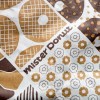
Proves that we have a soft spot for flowers, wind, and little wavy boats.
Kanji is the bane of anyone trying to learn Japanese due to its complexity and each character having multiple readings, not to mention that a single kanji can have as many as 13 syllables. But when skillfully written by hand, they can instantly turn into graceful art pieces.
Kouka Awazu comes from a long line of master calligraphers, and she has been the head of her own calligraphy school for more than 25 years. Starting at the tender age of 10, she has won numerous prizes in contests, as well as guiding over 10,000 students in the ways of the brush and ink.
Kouka also has an incredible amount of experience instructing foreigners too, and she has noticed that they tended to prefer certain kanji over others. Here’s the list of top 10 kanji that foreigners like according to her, with her explanations as to why.
10. Advance (susumu)
The 隹 radical is associated with a bird, which seems to be sitting on a boat traveling over sea. Kouka says that students often find this kanji rather interesting.
▼ It looks rather stylish too.
The kanji means to move on, 進 #書道 #calligraphy pic.twitter.com/01JjAKmYRT
— Japan Guided Tour (@GUIDEJAPANTOURS) November 4, 2015
9. Flower (hana)
Preferred by women, this tasteful kanji can be written using different ink colors to resemble blossoms, or written in a cursive style to symbolize vines.
▼ It kind of looks like a plant
when written in a flowing style.
My Japanese calligraphy work "花 Hana - Flower" on the wall of the gallery Kamiya-Art in Nihonbashi Tokyo. pic.twitter.com/nuQUIghA6C
— JINMO (@JINMOxxx) July 4, 2017
8. Love (ai)
This elegant kanji symbolizes love, and what makes it even more significant is that the radical situated right in the middle is 心 (kokoro), which means “heart”.
▼ It’s easy to fall in love with this kanji.
That is my work【-愛-】#Calligraphy#kanji#movie#paint
— 書道家 真澪(shinrei) (@shinreihori) October 5, 2017
#書道#真澪 #書道パフォーマンス #illustration#shodo #artist#design#beautiful#Art pic.twitter.com/q1O7qXOqwr
7. Work (hataraku)
Combine the three radicals “person”, “heavy” and “strength”, and you get a kanji that’s notoriously difficult to write, but as equally satisfying when completed.
6. Journey (tabi)
Being in Japan is a journey in itself, and this word no doubt resonates strongly with foreigners.
▼ These strokes almost have a bit of a blur to them,
like they’re hurrying along on their own journey.
beifongkendo:
— LemonCake (@S_LemonCake) September 17, 2016
Kanji calligraphy of “旅” (ryo, tabi), meaning travel or journey. # #tumblr pic.twitter.com/rtCURrhAPZ
5. Dream (yume)
Whether it’s English or Japanese, the word “dream” inspires hope and a better future.
▼ I dream about being able to do calligraphy this nicely….
That is my work【-夢-】#Calligraphy#kanji#movie#paint
— 書道家 真澪(shinrei) (@shinreihori) October 16, 2017
#書道#真澪 #書道パフォーマンス #illustration#shodo #artist#design#beautiful#Art pic.twitter.com/a54a1Tt5us
4. Reverberate (hibiki)
The 音 radical, which means sound, supports the kanji from below. Kouka claims that foreigners enjoy writing the squiggly portion on the top that resembles echoes.
▼ It certainly reverberates with us too!
https://twitter.com/shinreihori/status/8947395990539059203. Path (michi)
Students just love drawing the little wavy boat at the bottom, and having the profound meaning of walking one’s path in life is an extra bonus.
▼ It’s kind of beautiful watching the path
a brush takes to write “path.”
2. Wind (kaze)
This kanji is rather popular with men, and it can be as flexible as the previous entry for “flower” in that bold brush strokes signify gales while delicate ones signify gentle breezes.
▼ As if the wind itself is blowing the brush, guiding it.
#aloha #Hawaii #Japanese #Calligraphy #Pentel #brushlettering #Wind #ハワイ #風 #筆遊び #筆文字アート #筆文字 #書アート #ぺんてる #彩波ALOHAARTY #168ALOHAARTY pic.twitter.com/ZEAmKmiKBu
— 168alohaArty (@168alohaArty) December 17, 2016
1. Beauty (bi)
The word for “beauty” is the most requested kanji by foreigners as a gift for loved ones, or simply for the fact that it’s a quality that most people seek.
▼ All we can say is, beautiful.
That is my work【-美-】#Calligraphy#kanji#movie#paint
— 書道家 真澪(shinrei) (@shinreihori) September 27, 2017
#書道#真澪 #書道パフォーマンス #illustration#shodo #artist#design#beautiful#Art#書道家 pic.twitter.com/g39AydiXfW
There are loads of interesting kanji out there with profound meanings, each with unique ways of writing and packed with little stories to tell if you know where to look. It can be fun finding your favorite kanji, especially ones that have meanings completely different from what you may guess.
Source: Goo Rankings, Kouka no Sho
Top image: GAHAG











 Japan announces Kanji of the Year for 2019, and it was really the only logical choice
Japan announces Kanji of the Year for 2019, and it was really the only logical choice Watch this renowned Japanese calligrapher effortlessly write “the hardest kanji ever”【Video】
Watch this renowned Japanese calligrapher effortlessly write “the hardest kanji ever”【Video】 Japan’s Kanji of the Year revealed, reflects both the good and the bad of 2022
Japan’s Kanji of the Year revealed, reflects both the good and the bad of 2022 Testing Japan’s gacha capsule toy calligraphy brushes – tranquility for just 200 yen【Photos】
Testing Japan’s gacha capsule toy calligraphy brushes – tranquility for just 200 yen【Photos】 Meaning of life discovered using Japanese calligraphy, math, and puns
Meaning of life discovered using Japanese calligraphy, math, and puns Foreigner’s request for help in Tokyo makes us sad for the state of society
Foreigner’s request for help in Tokyo makes us sad for the state of society FUK COFFEE?!? Japanese cafe has a perfectly innocent reason for its startling-looking name
FUK COFFEE?!? Japanese cafe has a perfectly innocent reason for its startling-looking name Bad tourist manners at Mt Fuji Lawson photo spot prompts Japanese town to block view with screens
Bad tourist manners at Mt Fuji Lawson photo spot prompts Japanese town to block view with screens Two things to do, and two things not to do, when leaving a traditional Japanese inn
Two things to do, and two things not to do, when leaving a traditional Japanese inn One of Japan’s oldest castles now lets travelers spend night on the grounds, drink in its keep
One of Japan’s oldest castles now lets travelers spend night on the grounds, drink in its keep Japanese-style accommodation at the new Premium Dormy Inn hotel in Asakusa will blow your mind
Japanese-style accommodation at the new Premium Dormy Inn hotel in Asakusa will blow your mind Japanese city loses residents’ personal data, which was on paper being transported on a windy day
Japanese city loses residents’ personal data, which was on paper being transported on a windy day McDonald’s Japan’s new pancake pie is a taste sensation
McDonald’s Japan’s new pancake pie is a taste sensation Studio Ghibli unveils massive T-shirt collection featuring top anime movie characters
Studio Ghibli unveils massive T-shirt collection featuring top anime movie characters Mister Donut’s new Kyoto roasted green tea donut is a mess…in the best possible way
Mister Donut’s new Kyoto roasted green tea donut is a mess…in the best possible way Japanese ramen restaurants under pressure from new yen banknotes
Japanese ramen restaurants under pressure from new yen banknotes Red light district sushi restaurant in Tokyo shows us just how wrong we were about it
Red light district sushi restaurant in Tokyo shows us just how wrong we were about it McDonald’s new Happy Meals offer up cute and practical Sanrio lifestyle goods
McDonald’s new Happy Meals offer up cute and practical Sanrio lifestyle goods Tokyo Tsukiji fish market site to be redeveloped with 50,000-seat stadium, hotel, shopping center
Tokyo Tsukiji fish market site to be redeveloped with 50,000-seat stadium, hotel, shopping center Beautiful Red and Blue Star luxury trains set to be Japan’s new Hokkaido travel stars
Beautiful Red and Blue Star luxury trains set to be Japan’s new Hokkaido travel stars Ghibli Park now selling “Grilled Frogs” from food cart in Valley of Witches
Ghibli Park now selling “Grilled Frogs” from food cart in Valley of Witches New definition of “Japanese whiskey” goes into effect to prevent fakes from fooling overseas buyers
New definition of “Japanese whiskey” goes into effect to prevent fakes from fooling overseas buyers Our Japanese reporter visits Costco in the U.S., finds super American and very Japanese things
Our Japanese reporter visits Costco in the U.S., finds super American and very Japanese things All-you-can-drink Starbucks and amazing views part of Tokyo’s new 170 meter-high sky lounge
All-you-can-drink Starbucks and amazing views part of Tokyo’s new 170 meter-high sky lounge More foreign tourists than ever before in history visited Japan last month
More foreign tourists than ever before in history visited Japan last month New Pokémon cakes let you eat your way through Pikachu and all the Eevee evolutions
New Pokémon cakes let you eat your way through Pikachu and all the Eevee evolutions Disney princesses get official manga makeovers for Manga Princess Cafe opening in Tokyo
Disney princesses get official manga makeovers for Manga Princess Cafe opening in Tokyo We try out “Chan Ramen”, an underground type of ramen popular in the ramen community
We try out “Chan Ramen”, an underground type of ramen popular in the ramen community Sales of Japan’s most convenient train ticket/shopping payment cards suspended indefinitely
Sales of Japan’s most convenient train ticket/shopping payment cards suspended indefinitely Sold-out Studio Ghibli desktop humidifiers are back so Totoro can help you through the dry season
Sold-out Studio Ghibli desktop humidifiers are back so Totoro can help you through the dry season Japanese government to make first change to romanization spelling rules since the 1950s
Japanese government to make first change to romanization spelling rules since the 1950s Ghibli founders Toshio Suzuki and Hayao Miyazaki contribute to Japanese whisky Totoro label design
Ghibli founders Toshio Suzuki and Hayao Miyazaki contribute to Japanese whisky Totoro label design Doraemon found buried at sea as scene from 1993 anime becomes real life【Photos】
Doraemon found buried at sea as scene from 1993 anime becomes real life【Photos】 Tokyo’s most famous Starbucks is closed
Tokyo’s most famous Starbucks is closed One Piece characters’ nationalities revealed, but fans have mixed opinions
One Piece characters’ nationalities revealed, but fans have mixed opinions We asked a Uniqlo employee what four things we should buy and their suggestions didn’t disappoint
We asked a Uniqlo employee what four things we should buy and their suggestions didn’t disappoint Tired of wasting paper practicing your kanji? Try these reusable water-activated practice sheets
Tired of wasting paper practicing your kanji? Try these reusable water-activated practice sheets “Gold” named 2016 Kanji of the Year
“Gold” named 2016 Kanji of the Year Foreigners in Japan vote for the best-looking katakana character
Foreigners in Japan vote for the best-looking katakana character Foreigners misreading Japanese kanji of “two men one woman” is too pure for Japanese Internet
Foreigners misreading Japanese kanji of “two men one woman” is too pure for Japanese Internet Kanji Tetris is the coolest way to practice and play with Japanese that we’ve ever seen【Video】
Kanji Tetris is the coolest way to practice and play with Japanese that we’ve ever seen【Video】 “Safety” voted Japan’s official kanji of 2015
“Safety” voted Japan’s official kanji of 2015 Personified emotions from Pixar’s “Inside Out” get nifty kanji makeover in Japanese posters!
Personified emotions from Pixar’s “Inside Out” get nifty kanji makeover in Japanese posters! Japanese study tip: Imagine kanji characters as fighting game characters, like in this cool video
Japanese study tip: Imagine kanji characters as fighting game characters, like in this cool video W.T.F. Japan: Top 5 most difficult kanji ever【Weird Top Five】
W.T.F. Japan: Top 5 most difficult kanji ever【Weird Top Five】 Totoro beer? Hayao Miyazaki draws new version of anime icon for Japanese craft beer label
Totoro beer? Hayao Miyazaki draws new version of anime icon for Japanese craft beer label Four new era names the Japanese government rejected before deciding on Reiwa
Four new era names the Japanese government rejected before deciding on Reiwa Japan’s top baby names for 2015: Will Naruto-influenced monikers still reign supreme?
Japan’s top baby names for 2015: Will Naruto-influenced monikers still reign supreme? Twitter users say Japanese Prime Minister’s name is hiding in the kanji for Japan’s new era name
Twitter users say Japanese Prime Minister’s name is hiding in the kanji for Japan’s new era name Japanese government tells teachers not to be so strict, at least about some kanji radicals
Japanese government tells teachers not to be so strict, at least about some kanji radicals Kanji fail — Japanese parents shocked to learn their baby girl’s name has inappropriate meaning
Kanji fail — Japanese parents shocked to learn their baby girl’s name has inappropriate meaning
Leave a Reply